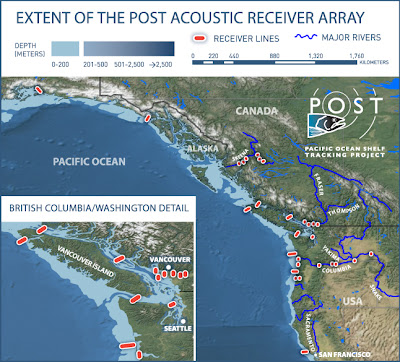(Lingcod. Photo by Jim Lyle at DiveBums. This site hosts a wealth of photo beauties, worth an extended visit.)
A new paper in PLoS ONE reports the whereabouts of tagged lingcod in Alaskan waters over the course of 16 months. Several aspects of this research are interesting.
First up, lingcod (Ophiodon elongatus) are large bottom-dwelling fish up to five feet long and 130 pounds, who live at least 20 years. They inhabit only the kelp forests, rocky shorelines, and tidal inlets of the Northeast Pacific from Mexico to Alaska.
The males are nest-guarders who move into shallow waters to defend territories prior to spawning. This leaves the species highly susceptible to overfishing, since the males are tied to the nest in inshore waters (read: easy to catch), and since catching a male will also result in the death of all his dependent offspring. From the paper:
So the researchers set out to see what they could learn about subpopulations of lingcod. Do they move around, do they mix, and if so where do they go at what ages and is that true for for males and females? The who-what-where-when-why-and-how of science.
Lingcod... support an important recreational and commercial fishery. Currently, lingcod is a species of critical concern to fisheries managers throughout the Pacific Coast because of the combined factors of low annual productivity and susceptibility to overfishing are a result of their high site residency and association with the nearshore zone. In Canada's Strait of Georgia, the lingcod commercial fishery has been closed since 1990 while in Washington, Oregon, and California lingcod was declared an overfished species between 1999 and 2005.
So the researchers set out to see what they could learn about subpopulations of lingcod. Do they move around, do they mix, and if so where do they go at what ages and is that true for for males and females? The who-what-where-when-why-and-how of science.
(The POST array in 2010.)
They tapped into POST (Pacific Ocean Shelf Tracking Project), an acoustic receiver array stretching from San Francisco to Alaska. It's one of 17 projects of the Census of Marine Life that's shedding light on more than a few sea mysteries:
That's a lot of aquatory for a smolt.
- Green sturgeon in the Sacramento River swim regularly from California to British Columbia and sometimes as far as Alaska.
- Salmon smolts swim downstream along the Columbia River and up the continental shelf to Southeast Alaska, a 2,500 kilometer/1,500 mile journey of ~3 months—roughly 25 kilometers/15 miles a day.
That's a lot of aquatory for a smolt.
(Coho salmon smolt. Photo by Cacophony, courtesy Wikimedia Commons.)
POST works with acoustic receivers anchored near the seafloor and close enough together that tagged animals swimming by are heard by at least one receiver. Thanks to the wonders of this distant listening array, revelations about lingcod life are emerging from the saltwater.
We used [POST] to monitor movements and residency of 21 acoustic-tagged lingcod for up to 16 months. Eight of sixteen lingcod (50%) initially aged at 2.5- to 3.5- years-old dispersed from their tag site. Dispersal was highly seasonal, occurring in two, five-week periods from mid-December through January and from mid-April through May. Dispersal in winter may be related to sexually immature lingcod or newly-mature male lingcod being displaced by territorial males. Spring dispersal may be indicative of the onset of migratory behavior where lingcod move out into Prince William Sound and possibly the offshore waters of the Gulf of Alaska.
(From PLoS ONE.)
The diagram above shows the what, where, when, how, and who of eight lingcod dispersing from their tagging areas.
- a) Lingcod dispersing out of Port Gravina, spring 2009.
- b) Lingcod dispersing from their tagging site in spring 2009 and remaining in Port Gravina.
- c) Lingcod dispersing out of Port Gravina, fall 2009.
- d) Lingcod dispersing out of Port Gravina, winter 2009–2010. Colored lines denote individual lingcod and arrows denote direction of travel. Dashed lines indicate absences >1 d without detection.
The tagging also revealed at least a few of the why's in lingcod life. Some left their home waters for periods up to seven days when Pacific herring migrated through—presumably in pursuit of their prey. Some fell prey to predators themselves.
Unexpectedly, our acoustic array provided accurate information on the timing and direction of a lingcod being preyed upon and removed from the study area. We were able to conclude that the predator was likely a marine mammal based on its speed, and in this case, the depth of the predator as the lingcod had a pressure sensor tag implanted.
Finally, a teaser of the lingcod's beautiful, plankton-infused world, translated into our native visual language.
The paper:
- 2010 An In Situ, Individual-Based Approach to Quantify Connectivity of Marine Fish: Ontogenetic Movements and Residency of Lingcod. PLoS ONE 5(12): e14267. DOI:10.1371/journal.pone.0014267













No comments:
Post a Comment